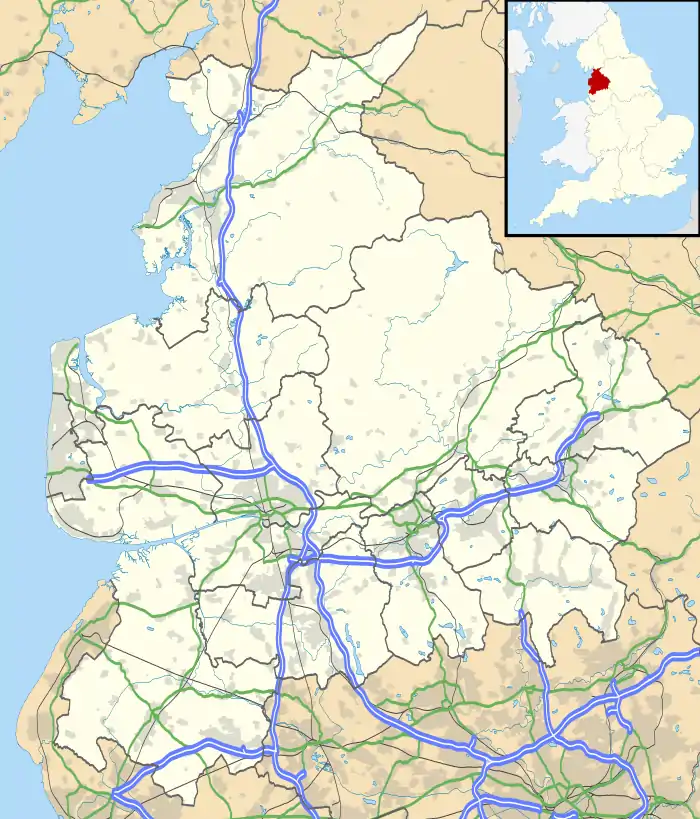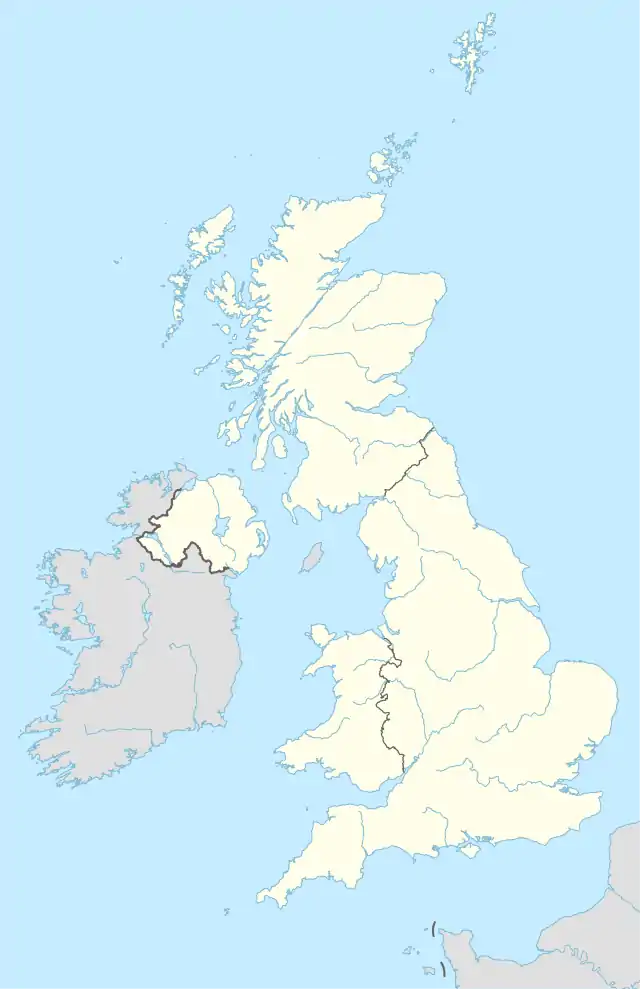Battle of Bamber Bridge
The Battle of Bamber Bridge was an outbreak of racial violence between Black and white American servicemen stationed in the British village of Bamber Bridge, Lancashire in June 1943. The incident, which occurred a few days after the 1943 Detroit race riot, began when white Military Police (MPs) attempted to arrest several African American soldiers from the racially segregated 1511th Quartermaster Truck Regiment at Ye Old Hob Inn public house in Bamber Bridge.
| Battle of Bamber Bridge | |||
|---|---|---|---|
.jpg.webp) Ye Old Hob Inn, where the violence started | |||
| Date | 24–25 June 1943 | ||
| Location | Bamber Bridge, Lancashire, United Kingdom 53.7217°N 2.6621°W | ||
| Caused by | Racial tensions | ||
| Parties to the civil conflict | |||
| |||
| Casualties | |||
| Death(s) | 1 | ||
| Injuries | 7 | ||
| Charged | mutiny | ||
 Location of Bamber Bridge  Battle of Bamber Bridge (the United Kingdom) | |||
After the arrival of more military police armed with machine guns, Black soldiers armed themselves with rifles from their base armoury. Both sides exchanged fire through the night. One Black soldier was killed and several MPs and soldiers injured. A court martial convicted 32 African American soldiers of mutiny and related crimes.[1]
Background
During the Second World War, Bamber Bridge hosted American servicemen from the 1511th Quartermaster Truck regiment, part of the Eighth Air Force. Their base, Air Force Station 569 (nicknamed "Adam Hall"), was situated on Mounsey Road, part of which still exists now as home to 2376 (Bamber Bridge) Squadron of the Royal Air Force Air Cadets (or Air Cadets). The 1511th Quartermaster Truck was a logistics unit, and its duty was to deliver materiel to other Eighth Air Forces bases in Lancashire.[2] The 234th US Military Police Company were also located in the town, on its north side.[1]
US Armed Forces were still racially segregated, and the soldiers of 1511 Quartermaster Truck were almost entirely Black, while all but one of the officers were white, as were the MPs. Military commanders tended to treat these service units as "dumping grounds" for less competent officers, and leadership in the unit was poor.[3] Racial tensions were exacerbated by the riots in Detroit earlier that week which had led to 34 deaths, including 25 Black casualties.[4] The people of Bamber Bridge supported the Black troops, and when American commanders demanded a colour bar in the town, all three pubs in the town reportedly posted "Black Troops Only" signs.[5]
Outbreak of violence
On the evening of 24 June 1943 some soldiers from the 1511th Quartermaster Truck regiment were drinking with the English townsfolk in Ye Old Hob Inn. Two passing MPs, Corporal Roy A. Windsor and Private First Class Ralph F. Ridgeway, entered the pub and attempted to arrest one soldier (Private Eugene Nunn) upon seeing he was improperly dressed (in a field jacket rather than class A uniform). An argument ensued between the Black soldier and the white MPs, with local people and British servicewomen of the Auxiliary Territorial Service siding with Nunn.[1] Even a white British soldier challenged the MPs saying "Why do you want to arrest them? They're not doing anything or bothering anybody."[6]
Black Staff Sergeant William Byrd defused the situation but as the MPs left a beer was thrown at their jeep. After the MPs picked up two reinforcements, they spoke to Captain Julius F. Hirst and Lieutenant Gerald C. Windsor who told the MPs to do their duty and arrest the Black soldiers. A group of MPs intercepted the soldiers on Station Road as they returned to their base at Mounsey Road. A fight broke out in the road leading to shots being fired. One struck Private William Crossland in the back killing him.[6]
When some of the injured Black soldiers returned to their base, the killing caused panic as rumours began to spread that the MPs were out to shoot Black soldiers. Although the colonel was absent, acting CO Major George C. Heris did his best to calm the situation. Lieutenant Edwin D. Jones, the unit's only Black officer, was also able to persuade the soldiers that Heris would be able to round up the MPs and see that justice was done.[1][3]
However, at midnight, several jeeps full of MPs arrived at the camp, including one improvised armoured car armed with a large machine gun. This prompted Black soldiers to arm themselves with weapons. Around two-thirds of the rifles were taken, and a large group left the base in pursuit of the MPs.[1] British police officers claimed that the MPs set up a roadblock and ambushed the soldiers.[4]
The Black soldiers warned the townspeople to stay inside when a firefight broke out between them and the MPs resulting in seven wounded. The shooting stopped around 4 a.m. the next morning. Eventually, the soldiers returned to the base, and by the afternoon all but four rifles had been recovered.[1][3]
Arrest and court martial
The violence left one man dead and seven people (five soldiers and two MPs) injured.[3] Although a court martial convicted 32 African American soldiers of mutiny and related crimes, poor leadership and racist attitudes among the MPs was blamed as the cause.[1]
General Ira C. Eaker, commander of the Eighth Air Force, placed the majority of the blame for the violence on the white officers and MPs because of their poor leadership and the use of racial slurs by MPs. To prevent similar incidents happening again, he combined the Black trucking units into a single special command. The ranks of this command were purged of inexperienced and racist officers, and the MP patrols were racially integrated. Morale among Black troops stationed in England improved and the rates of courts-martial fell. Although there were several more racial incidents between Black and white American troops in Britain during the war, none were on the scale of Bamber Bridge.[2][5]
Reports of the mutiny were heavily censored, with newspapers only disclosing that violence had occurred in a town somewhere in North West England.[7] The author Anthony Burgess, who lived in the Bamber Bridge area after the War, wrote about the event briefly in The New York Times in 1973 and in his autobiography, Little Wilson and Big God.[5][8] Popular interest in the event increased in the late 1980s after a maintenance worker discovered bullet holes from the battle in the walls of a Bamber Bridge bank.[9]
Commemoration
In June 2013, to commemorate the 70th anniversary of the incident, the University of Central Lancashire held a symposium.[10] It included a screening of the 2009 documentary Choc'late Soldiers from the USA[upper-alpha 1] which was produced by Gregory Cooke, and a performance of Lie Back and Think of America, a play written by Natalie Penn of Front Room that had played at the Edinburgh Fringe Festival.[10]
References
Notes
- "A landmark documentary explores how African American soldiers and British civilians formed an unexpected bond during World War II" which had its world premier at the Smithsonian Institution National Museum of African American History and Culture on 10 November 2009. American History and Culture[11]
Citations
- Werrell, Ken (1978). Ramsey, Winston G. (ed.). "The Mutiny at Bamber Bridge". After the Battle. No. 22. pp. 1–11.
- Miller, Donald L. (2007). Masters of the Air: America's Bomber Boys Who Fought the Air War Against Nazi Germany. New York, NY: Simon and Schuster. pp. 227–229. ISBN 9780743235457.
- Nalty, Bernard C. (1 January 1986). Strength for the Fight: A History of Black Americans in the Military. Simon and Schuster, Free Press. pp. 154–157, 228. ISBN 9780029224113.
- "When the American military said sorry to Bamber Bridge". Lancashire Evening Post. 12 April 2012. Archived from the original on 2 July 2018. Retrieved 2 June 2017.
- Pollins, Harold. "WW2 People's War – The Battle of Bamber Bridge". BBC. Retrieved 4 April 2017.
- "Black troops were welcome in Britain, but Jim Crow wasn't: the race riot of one night in June 1943". www.theconversation.com. 22 June 2018.
- Rogerson, Derek (24 June 2018). "When race riots sparked a gun battle on streets of Bamber Bridge". Lancashire Evening Post. Retrieved 5 April 2019.
- "In the Other England, the Land of Cotton, Nobody Says 'Baaaaath'". 28 January 1973. Retrieved 5 April 2019.
- Rice, Alan (22 June 2018). "Black troops were welcome in Britain, but Jim Crow wasn't: the race riot of one night in June 1943". The Conversation. Retrieved 5 April 2019.
- "Sollis Marks 70th Anniversary of Battle of Bamber Bridge". Lancashire, U.K.: University of Central Lancashire. Retrieved 2 June 2017.
- "Choc'late Soldiers from the USA: Love, War and Change" (PDF). Journal of African American History. Retrieved 2 June 2017.